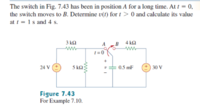Mathmasteriw
Junior Member
- Joined
- Oct 22, 2020
- Messages
- 85
Yes it's part of a intergation problemIs this part of an integration problem?
Oh ok then. Now it's a bit clearer.I know in the original photo there is a 2 and a 0 but for my question i would use 1 and 0
Were does numbers originally the limits of integration? As the 2 and 3 are in [math]\int_2^3f(t)dt?[/math]Yes it's part of a intergation problem
The notation you're asking about means "evaluate the difference in the expression when t changes from 0 to 2"; that is, \([f(t)]_a^b\) means \(f(b) - f(a)\).Hi Guys and gals,
can anyone explain what the 2 & 0 on top and bottom of the square brakets do in relation to inside the brakets?
For example the answer i get for inside brakets are = 0.37 but what effect do these numbers have on this answer?
Any help appreciated!
View attachment 24387

Thanks for that, it explains much better in here than my workbook!The notation you're asking about means "evaluate the difference in the expression when t changes from 0 to 2"; that is, \([f(t)]_a^b\) means \(f(b) - f(a)\).
This should be explained in your textbook; if not, see "Example (continued)" in https://www.mathsisfun.com/calculus/integration-definite.html, or the statement of the theorem in https://tutorial.math.lamar.edu/classes/calci/computingdefiniteintegrals.aspx
